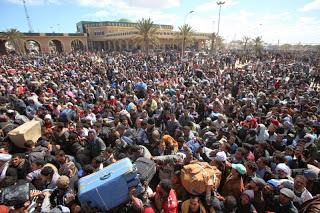 The stories of the drowning deaths of what may be as many as 950 migrants in the Mediterranean is both tragic and frightening. Tragic in the magnitude and heartrending nature of the human suffering in this escalating calamity. Frightening in its portent of things to come.
The stories of the drowning deaths of what may be as many as 950 migrants in the Mediterranean is both tragic and frightening. Tragic in the magnitude and heartrending nature of the human suffering in this escalating calamity. Frightening in its portent of things to come.At least 3,200 perished on the journey between Libya and Italy in 2014, according to the International Organization for Migration, making it the deadliest migrant route in the world. These poor, exploited people are fleeing brutal terrorists, civil wars, human rights abuses, and manifold deprivations. Our hearts go out to them. But not our hands.
It is estimated that 170,000 illegal migrants reached European Union Mediterranean shores in 2014. Most from sub-Saharan Africa. The last thing European leaders want is to offer them asylum or even temporary safe haven. The potential economic and societal consequences of taking on hundreds of thousands of poverty-stricken people from a vastly different cultural with minimal labor skills is daunting. It is understandable, if not laudatory, that the EU and Italy have invested millions of Euros in detention and deportation efforts, while maintaining pressure on countries like Libya to block the passage of migrants and asylum seekers hoping to make it to Europe.
In its study, National Security Implications of Climate Change for U.S. Naval Forces (National Academy of Sciences, 2011), the Naval Studies Board estimated that, “ Two hundred million people could be newly mobilized as climate migrants due to climate change effects.” The Navy study tells us that many of these unfortunates will come from the selfsame sub-Saharan Africa because of its climate vulnerability. Many more will come from island nations and low-lying regions like Bangladesh, due to sea level rise. U.S. coastal areas will also be affected. The Navy plans to be ready to provide what promises to be a herculean humanitarian effort, but also to quell, “instability as well as unrest and regional conflict,” due to climate forced migrations.
But this won’t happen in our lifetime, right? Not if you’re my age (77). But my children could well be around, and certainly my grandchildren will live to experience this catastrophic scenario, because the Navy is projecting all this will occur by 2050. If we allow this to happen, it will make the on-going human migration calamity pale by comparison.

How can we stop it? We can’t do it by denying climate change or refusing to talk about it -- that’s clear. Unfortunately, it’s not clear our ‘leaders’ locally or in Washington have the political will to address the problem. It’s up to us -- you and me -- to create that political will by exercising our personal power through informed activism. Yes, it takes effort, but believe me, the Internet makes it a lot easier today than during my early days. Look, preventing the kind of tragedy we’re seeing today, but on a massively larger scale has to be worth the effort, doesn’t it?

